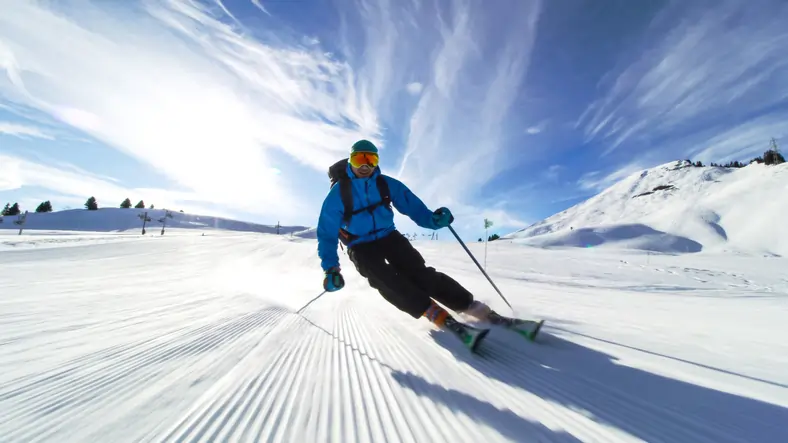
Skiing in extreme cold requires the right combination of gear, materials, and layering to ensure comfort and safety. Choosing the appropriate ski jacket, gloves, and accessories can make a big difference in maintaining warmth while allowing flexibility for movement. Breathable and waterproof fabrics help regulate body temperature, while insulation technologies provide reliable heat retention even in damp conditions.
Small details, such as moisture-wicking base layers, heated accessories, and proper ventilation systems, contribute to a more comfortable experience on the slopes. Additionally, properly maintaining ski gear helps extend its lifespan, ensuring continued protection against harsh weather. With the right preparation, Andrew Byer showcases how skiers can confidently tackle freezing temperatures while staying warm throughout their adventures.
Choosing the Right Ski Jacket
Selecting the right ski jacket is paramount for staying warm and dry in extreme cold. Waterproofing, insulation, and breathability are key factors to consider. A high-quality jacket should keep moisture out while allowing sweat to escape, preventing dampness that can lead to discomfort. Insulation types like down and synthetic materials provide varying levels of warmth, with synthetic options offering better performance in wet conditions. Some jackets also incorporate hybrid insulation, combining the best of both materials for optimal warmth and moisture resistance.
Different types of jackets serve specific needs. Hard-shell jackets provide maximum protection against wind and moisture, making them ideal for harsh weather. Softshell options offer flexibility and breathability but may require additional layering in extreme cold. Insulated jackets provide built-in warmth, reducing the need for extra layers. Choosing the right jacket depends on weather conditions and personal preferences, ensuring the best combination of protection and comfort.
Essential Ski Gear for Extreme Cold
Keeping hands, feet, and the head warm is crucial when skiing in freezing temperatures. Insulated gloves or mittens with waterproof exteriors help retain heat while preventing moisture from seeping in. Heated options are also available for those who struggle with cold hands. Choosing gloves with adjustable cuffs ensures a secure fit, preventing snow from entering and causing discomfort.
Head protection goes beyond just a helmet. Wearing a balaclava or a thick beanie under the helmet helps prevent heat loss, as a significant amount of body warmth escapes through the head. Neck gaiters or fleece-lined face coverings provide additional protection against biting winds and blowing snow. These accessories make a noticeable difference in extreme conditions, especially during long hours on the slopes.
Feet are just as important. High-quality ski socks made from Merino wool or moisture-wicking synthetic fibers help keep toes warm and dry. Cotton should be avoided since it absorbs moisture and increases the risk of frostbite. Heated socks or boot warmers add an extra layer of comfort for those tackling sub-zero temperatures. A proper boot fit also plays a crucial role in warmth, as tight boots can restrict circulation.
Protective Accessories
Clear vision is essential for skiing safely in extreme weather. Goggles with anti-fog coatings and UV protection shield the eyes from glare and snow blindness. A snug fit prevents cold air from seeping in, ensuring visibility remains unobstructed even in icy conditions. Some models come with interchangeable lenses, allowing skiers to adapt to changing light conditions throughout the day. Polarized lenses can further enhance contrast and reduce glare, providing better visual clarity on bright, snowy days.
Face protection is often overlooked but plays a major role in staying comfortable. Harsh winds can cause skin irritation and even frostbite, making a wind-resistant face mask or neck gaiter an important addition. Fleece-lined options offer warmth, while breathable materials prevent moisture buildup from breath condensation.
Small accessories can make a big difference in maintaining warmth. Hand and foot warmers provide an extra heat source when temperatures drop. These compact heat packs can be slipped into gloves or boots, offering relief on particularly cold days. Many skiers keep a few on hand, ensuring they stay warm even if conditions become unexpectedly harsh.
Maximizing Comfort and Mobility
Finding the right balance between warmth and mobility is vital for an enjoyable skiing experience. A properly fitted jacket should allow for a full range of motion without feeling restrictive. Some designs incorporate articulated sleeves and stretch panels, ensuring skiers can move freely without compromising warmth. Layering strategically also helps maintain flexibility without unnecessary bulk. Opting for lightweight yet insulated clothing ensures warmth without sacrificing ease of movement on the slopes.
Bulky clothing can hinder performance, making it harder to navigate the slopes efficiently. Lightweight insulation and ergonomic designs help maintain warmth without adding excessive weight. Many high-performance ski jackets and pants are designed to contour the body, providing insulation without restricting movement. Choosing gear that enhances mobility allows skiers to stay agile, even in demanding conditions. Additionally, adjustable cuffs and hems provide a customizable fit, preventing snow and wind from entering while maintaining a comfortable feel.
Maintaining and Caring for Gear
Proper maintenance extends the lifespan of ski gear and ensures optimal performance. Regularly cleaning jackets and pants removes dirt and oils that can compromise waterproofing. Storing gear in a dry, well-ventilated area prevents mold and mildew buildup, and taking the time to air out gear after use reduces odors and ensures freshness.
Waterproofing treatments help restore a jacket’s ability to repel moisture. Over time, exposure to snow and rain can wear down the protective coating, making reapplication necessary. Sprays and wash-in treatments refresh the fabric’s water resistance, ensuring it continues to perform in harsh conditions. Some treatments also enhance breathability, preventing moisture buildup inside the jacket while maintaining dryness.
Small precautions can go a long way in keeping ski gear in top shape. Drying boots and gloves thoroughly after each use prevents unpleasant odors and prolongs their durability. Checking zippers, seams, and insulation for signs of wear allows for timely repairs, avoiding unexpected issues on the slopes. A little care goes a long way in preserving the quality and functionality of winter gear. Investing in proper storage solutions, such as breathable garment bags or boot dryers, further enhances longevity and ensures that equipment remains in peak condition.


